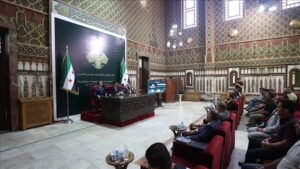
The National Interest Foundation Newsletter
Issue 304, October 3, 2025
Welcome to our NIF Newsletter. In this week’s edition, we delve into U.S. President Trump’s peace plan for Gaza and whether it is a workable one, examine some of the latest developments in Syria and the prospect of regional stability, and provide analysis regarding the Gaza Freedom Flotilla and Israel’s repeated attacks on it which violate international law.
Editor: Bassam Tarbush
Trump Peace Plan for Gaza: Is It a Workable Plan?

This week, U.S. President Donald Trump presented a peace plan for ending the war in Gaza, as the conflict nears its two-year mark. The framework agreement was unveiled during Israeli Prime Minister Benjamin Netanyahu’s visit to the White House and incorporated significant last-minute changes requested by him – infuriating Arab officials involved in the earlier negotiation process for the plan with Trump, which was developed over the span of the preceding weeks. The controversial edits that were incorporated dealt in particular with the conditions and timetable surrounding Israel’s withdrawal from Gaza, eliciting concern that Israeli forces will push to remain there indefinitely. The plan allows Israel to have veto power during the military withdrawal phases. Then, even after this is potentially completed, it calls for a “security perimeter” around Gaza maintained by Israeli forces until the territory is “secure from any resurgent terror threat” – a vague and arbitrary determination that fair-minded analysts fear could be used to try and justify continued Israeli military presence.
One of the other main aspects of the plan that has prompted unease over its workability and chances of success is the concern that it leaves the door open for Israel to resume its destructive military operations in Gaza at any time. The aforementioned Israeli veto power gives the Netanyahu government the ability to renege on the deal and reinitiate military hostilities – as it did back in March when it unilaterally broke the mid-January Gaza ceasefire agreement with Hamas. The lengthy period of stages for implementation of the plan also means that there will be many points where it will be susceptible to a breakdown and a possible future outbreak of violence. Due to what transpired in March and Netanyahu’s well-documented personal and political motivations to prolong the war, there is understandably a lack of trust that Israel will not seek to resume its military operations in Gaza and perpetuate its presence there – both of which are harmful to the prospect of peace moving forward.
Observers have also pointed out that Trump’s Gaza peace plan lacks important details regarding governance, security, and a concrete pathway for Palestinian self-determination, while being vague on how it could be successfully implemented. The plan calls for a transitional Palestinian committee of technocrats to govern Gaza but offers no insight into who would appoint them or the manner in which they would be selected. Additionally, it seeks to create an “International Stabilization Force” (ISF) to help provide sustained security in Gaza, however, the makeup of this force, its mandate, and rules of engagement have not been defined. Furthermore, the Trump plan does not set out clear milestones or timeframes for key elements, such as Israeli withdrawal from Gaza and a detailed path for Palestinian self-determination. Without these measurable benchmarks, external occupation and presence could become entrenched. On top of all of this, the plan fails to address major impediments that are central to any hope of comprehensive and lasting peace like illegal Israeli settlement expansion and the troubling uptick in settler violence in the occupied West Bank. There are serious conflict of interest concerns as well, given that Trump’s son-in-law Jared Kushner played an instrumental role in drafting the Gaza peace plan.
While the Trump peace plan for Gaza would provide a desperately needed halt to Israel’s calamitous military assault on the territory and pave the way for immediate humanitarian relief for besieged civilians on the ground, the rightful welcoming of this in the short term – should it be implemented – has still been coupled with valid concern regarding its potential viability in the long term. The plan leaves the pathway to Palestinian statehood and self-determination vague and contingent upon unlikely Israeli concessions, with no credible guarantees. In fact, in the aftermath of the plan’s unveiling, Netanyahu has boastfully made it clear regarding his unwavering opposition towards a Palestinian state and desire to continue undermining the peace process. Trump’s proposal primarily focuses on halting the military assault on Gaza – at least temporarily – but it essentially allows for prolonged occupation and fails to provide a sustainable political and diplomatic resolution for the underlying fundamental causes of the Israeli-Palestinian conflict. Thus, most experts and analysts contend that the Trump plan is not workable in the long run.
Syria and the Prospect of Regional Stability

Since the ousting of the Assad regime back in December of last year, Syria has been in the midst of a delicate political transition that many observers have outlined as being crucially important for the prospect of regional stability. The new government’s ability to unify the country and address significant economic, political, and humanitarian challenges will ultimately determine the path forward for Syria. One of the current developments that analysts are particularly keen to follow is the upcoming elections that are due to take place. The first parliamentary elections following the collapse of the previous regime are scheduled for this coming Sunday, October 5th, and will help produce a new People’s Assembly of Syria. While this will consist of an indirect and transitional voting system whereby one-third of representatives will be appointed by Syrian President Ahmed al-Sharaa, the elections represent a key step in the transitional process and the potential for increased governmental legitimacy in the eyes of the Syrian population and the world at-large.
Experts have highlighted that the process signals the interim government is interested in initiating institutional reconstruction and encouraging the political participation of its citizens. As such, the upcoming elections will serve as a vital test of the new administration’s commitment to building state institutions and creating a more inclusive civil society in the country. Others have also referenced how the formation of a new legislative body will offer a telling indication as to whether Syria’s current leadership is prepared to embrace pluralism and institutional reform. All of this comes at a critical time for the bolstering of the new government’s legitimacy, both domestically and internationally. Last week, Syrian President Ahmed al-Sharaa addressed the United Nations General Assembly (UNGA), marking the first time that a Syrian head of state had done so since 1967. The appearance at the UNGA was a notable occasion and signaled the country’s return to the international stage after decades of global isolation under the repressive Assad regime.
The new People’s Assembly of Syria that is slated to be formed following the upcoming parliamentary elections will include 210 members. It was initially planned to consist of 150 members but was later expanded after community consultations. Two-thirds of members will be selected through a committee-led process, while the remaining one-third will be appointed by the president. As for the reasoning behind the planned format of this upcoming election, Syrian authorities have expressed that it would not be feasible to create an accurate voter registry and conduct a popular vote at this junction given that millions of Syrians were internally or externally displaced by the country’s nearly 14-year conflict and many have lost personal documents. Thus, the intent is to have the newly established parliament serve a 30-month term, during which the government will prepare for a popular vote in the next elections.
Stability in Syria is vital to the entire region as a whole. Years of conflict between 2011 and 2024 under the now deposed Assad regime resulted in one of the largest displacement crises in the world, with millions of Syrians becoming refugees in neighboring countries like Turkey, Lebanon, Jordan, and Iraq. Therefore, increased stability and domestic societal improvements in Syria would help create the environment that allows many of those that were forcibly displaced to safely reintegrate. It can also alleviate humanitarian conditions in Syria by enabling the delivery of essential aid and attracting foreign investment in order to facilitate much-needed infrastructure reconstruction following decades of repressive rule. Additionally, a unified Syria will be less susceptible to destructive external interference (from Israel in particular) and mitigate regional tensions driven by outside forces. Ultimately, a stable Syria signals a commitment to peace and encourages increased regional and international diplomacy, support, and engagement in the country’s recovery and development.
Gaza Freedom Flotilla and Israel’s Repeated Violations of International Law

Repeated attacks against Gaza-bound humanitarian aid boats and seizures of them have drawn widespread and justifiable criticism from rights groups, government officials, and global bodies such as the United Nations. This diverse array of entities has sought to highlight how this behavior constitutes a flagrant violation of international law. Under the UN Convention on the Law of the Sea (UNCLOS), freedom of navigation must be upheld, and the peaceful passage of vessels should not be impeded. Despite this, humanitarian aid boats, including most recently the Global Sumud Flotilla, have been regularly subjected to drone attacks and other acts of sabotage attributed to Israel. The latest even prompted a host of countries like Spain, Italy, and Turkey to condemn these unlawful actions and dispatch naval assets in order to protect and monitor the aforementioned flotilla on its route.
There is a clearly documented pattern of Israeli forces illegally attacking and seizing humanitarian aid flotillas that are attempting to break the blockade of Gaza. The recent attacks on the Global Sumud Flotilla are far from an isolated incident. Just this year alone in 2025, several other activist vessels have been similarly targeted over the preceding months. Back in May, “The Conscience” was hit by two armed drones in international waters off of the coast of Malta; and in June, the crew of activists aboard “The Madleen” were forcefully detained and deported, as were those traveling on “The Handala” the following month in July. On top of the fact that these instances continue to take place without proper deterrent and punitive measures being enacted to prevent future occurrences, the brazen nature of them is also deeply alarming. In all of these cases, Israeli forces have committed these unlawful actions against peaceful humanitarian aid flotillas while these boats were in international waters or in port.
Under international law, those seeking to deliver humanitarian aid are meant to be explicitly protected. The Geneva Conventions stipulate this for medics, journalists, aid workers, and other civilians, while also establishing the right of populations in need to receive humanitarian relief. Thus, any attack or obstruction of a peaceful aid convoy is deemed to be a grave breach of international law. Furthermore, Article 8 of the Rome Statute of the International Criminal Court (ICC) defines intentionally directing attacks against “installations, material, units, or vehicles” involved in a humanitarian assistance mission as a war crime. It also criminalizes both the starvation of civilians as a method of warfare and the willful obstruction of humanitarian aid – two things that Israel has been consistently found to be doing in Gaza by impartial experts and observers. Ultimately, as a result of all of these factors and the Gaza Freedom Flotilla’s efforts to counter unlawful behavior, there is no denying that its boats warrant protection – particularly when there are multiple binding instruments of international law which are intended to guarantee their right to deliver humanitarian aid.
The Global Sumud Flotilla set sail back in late August and is made up of around 50 vessels with human rights activists, journalists, and artists from more than 44 different countries. On Wednesday, as had been anticipated, Israeli forces yet again violated international law by seizing the flotilla and detaining the activists on board its civilian boats who were seeking to deliver humanitarian aid to Gaza. A statement by the flotilla recounted how Israeli naval vessels intentionally damaged ship communications in an attempt to block distress signals and stop the livestream of their illegal boat boarding prior to doing so. As the numerous voices who condemned the move were quick to draw attention to, the seizure of boats in international waters was contrary to international law and violated the sovereignty of all the nations that took part in the flotilla. As such, unsurprisingly, Israel’s actions have garnered widespread denunciation and sparked protests in countries around the world.
